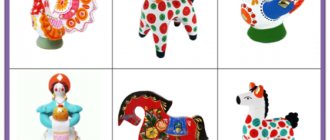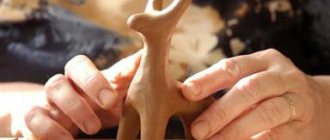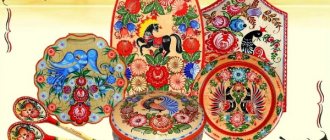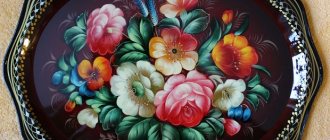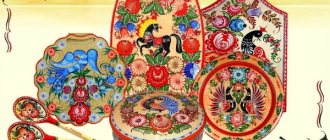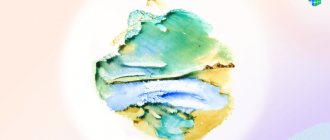Main differences
All types of Khokhloma paintings on household kitchen utensils have their own characteristics. It is from them that experts or simply knowledgeable people can talk about the creation technique. The name “Khokhloma” is one of the most popular among paintings. Not only experienced artists, but also preschoolers can learn to draw step by step. Khokhloma painting patterns for beginners include:
Grass patterns - a line curved to the side. To get it, you must first press the brush in the center, and then, moving it to the side, gradually reduce the pressure and gradually reduce the thickness.- Leaf is one of the simplest patterns. Mirror blades of grass are drawn, curved outward. All empty spaces are filled with paint of the same color.
- A curl curled like a snail is less common because it is more difficult to draw. It is important to maintain equal pressure on the hand.
- Droplet - the brush is placed at the base of the bristles and slowly turns 180 degrees, slightly moving forward and lifting off the surface. Drawing droplets helps train your hand to press correctly.
- A bush is a few droplets arranged in the form of a fan. A small dot is placed at its base.
GCD for drawing “Khokhloma spoons” for children of senior preschool age
Natalya Kharlanova
NOD for drawing “Khokhloma Spoons” for children of senior preschool age
Educational areas : artistic creativity, cognition, communication, socialization.
Preliminary work: Viewing the presentation “Golden Khokhloma”, conversations, classes about the history of fishing, features of Khokhloma painting, folk outdoor games.
Methodological tasks: Teach children a new composition of the Khokhloma pattern - an image of a rounded branch with berries, corresponding to the shape of the product. Learn to draw new pattern elements - currant berries. learn to draw patterns on backgrounds of different colors - red, black, yellow, and independently select paints for the pattern in accordance with the background.
Practice drawing already known pattern elements - grass, curls, leaves, berries.
Materials for the lesson: several spoons with a Khokhloma pattern; silhouettes of spoons cut out of paper; table with elements of the Khokhloma pattern - strawberries, raspberries, gooseberries, currants;; gouache; soft brushes.
Methodology:
Educator: Today we are visiting funny spoons. Look at them.
Where do you think they came to us from? How did you know that you were from Khokhloma? Determine the shape of the spoons (round or slightly oval.) Where is the pattern on the spoon? What does the pattern consist of (a branch with berries, leaves, curls.)
Why do you think Khokhloma artists decorate spoons with a rounded branch (The rounded branch corresponds to the round shape of the spoon). What is the edge of the spoon decorated with (Border.)
How the handle is colored (Its bottom and top edges are a different color than the middle.)
It is clarified where to start drawing (from the border).
The children get to work.
At the end of the lesson, the teacher suggests that each child talk about his drawn spoon: what color, what colors are used to draw the pattern, what color is the border and the tip of the handle. Self-analysis is carried out.
Presentation “Golden Khokhloma” In this presentation we will introduce preschool children to the arts and crafts of GOLDEN KHOKHLOMA. Let's give an idea about.
The mode of implementation of educational areas in the middle group Approved by: Head of MBDOU D/S 7 N. N. Lyubimova ___ The mode of implementation of educational areas in the process of children's activities.
Source
Features of the technology
It is customary to paint wooden products with Khokhloma: toys, dishes, etc. The finished product can be given as a gift or kept for home decoration. Before you start painting, you need to prepare all the materials and tools. To work you will need:
- a wooden board for cutting food or any other item for the base;
- adhesive;
- gouache or other paints;
- egg white;
- sheets of paper;
- pencils;
- brushes for painting of different thicknesses;
- varnish for fixing the pattern;
- paint brush.
After the above list and Khokhloma painting stencils have been collected, you can begin to work.
Step-by-step master class:
- Coat the wooden base well with egg white and let it soak in a little.
- Prepare a sketch drawing on a separate sheet.
- Cover a cutting board or other object with gold paint and wait until it dries completely.
- Using a pencil, carefully redraw the drawing from the sheet onto the base.
- Color all the ornaments of flowers and berries red.
- Using a thin brush, add curls, leaves and veins.
- Mark the boundaries of the patterns and outline them thicker.
Even though the base was painted gold, the final design should give the impression that the background is still black. The finished product should be allowed to dry, then check and complete the missing elements and green grass. Secure the design with a thin layer of varnish.
Summary of GCD in the senior group. Painting of Khokhloma spoon
Abstract of the GCD on artistic and aesthetic development “Painting the Khokhloma spoon.”
Senior group Priority educational areas : artistic, aesthetic, cognitive, social and communicative development. Types of activities : productive, communicative, gaming. Goal : to consolidate children's knowledge about Russian folk crafts through painting in the traditions of Khokhloma. Objectives : artistic and aesthetic
: • repeat the types of Russian folk crafts studied earlier;
• develop creative skills, aesthetic perception; • continue to introduce children to decorative drawing; • consolidate knowledge about the specifics of Khokhloma painting (color scheme, features of the ornament). • develop the ability to perform movements to music, observing the rhythm. social and communicative
: • cultivate love and respect for the work of craftsmen, teachers, and other children;
• to form children’s ideas about other regions of Russia, cities, and folk heritage; • expand children's vocabulary with new words and terms. educational • to form children’s understanding of work, of people’s artistic professions, • to tell about wood as a material for making Khokhloma dishes. Materials and equipment : demonstration
: • Khokhloma dishes;
• tables with images of Khokhloma dishes; • table with elements of painting; • posters; • photos; • decorative spoon blanks without a pattern; • CD with folklore music. dispensers
: • spoon blanks without painting;
• watercolor paints; • postcards with images of Khokhloma dishes for each child; • preliminary work by the children themselves with pattern elements. interactive
: • mind maps;
• interactive crossword puzzle. Character Leshy Preliminary work: • conversation, examination of Khokhloma originals, pictures, postcards, photographs;
• a story about the masters of Khokhloma; • drawing elements of painting in workbooks (according to tables). Progress of the lesson
1. Introductory part with mind maps Children sit in a semicircle.
The teacher begins the lesson, shows slides with prepared mind maps, which provide brief descriptions of various types of folk crafts. Children repeat the material they have studied, answer questions, and explain their answers. After repeating the material, move on to the second part of the lesson. 2. Main part The teacher brings out the originals of Khokhloma dishes and invites the children to carefully examine them. Educator : Guys, look at what beautiful products the folk craftsmen have created for us! Do you know what this wonderful painting is? Children's answers. Educator : Yes, that's right. This is real wooden tableware with unusual Khokhloma painting. Tell me, what's special about it? Children's answers. Educator : Correct. This beautiful painting that you see has been created by masters for many years. (What follows is the teacher’s story about how Khokhloma masterpieces are made; at the end of the story, the teacher invites the children to recite a couple of poems on the topic of the lesson by heart). Reading poems. Khokhloma, Khokhloma, Golden Beauty! Everyone knows it, Our painting is dear. And whoever you ask, anyone will answer: “The pride of dear Rus' is our Khokhloma pattern!” Educator : Well done, guys! With your poems you told us about the beauty of folk painting. Khokhloma is an ancient village where craftsmen came up with the idea of painting not only dishes, but also furniture. She was very fond of the trading people for her bright colors and interesting characters - berries, flowers and birds. As the story progresses, the teacher draws the children’s attention to a mind map with the stages of production of Khokhloma dishes. Educator : When the product is completely ready, oil paints are used to paint it. The main colors that determine the character and recognition of the painting are red and black. The masters make brushes from squirrel fur on the tail, so that they can draw a very thin, barely noticeable line. Can you imagine how much work this is? Next, the teacher reminds the children how to apply the Khokhloma pattern with a brush. 3. Physical education lesson The teacher performs ditties, folk music sounds. Children move to it, using elements of Russian folk dances. Reading ditties. Khokhloma is all out and about: They danced at home too! Here the spoons are playing - Timoshka cannot be appeased! And Ivan shouts from the stove: “Where are all the rolls?” Don’t be lazy, Vanyusha, hit the bullseye quickly! The master will do the dishes, but Ivan shouts: “I won’t! I like the colors - I’ll paint them to perfection!” But I took up my brushes and was immediately confused! And there is a cry in the village: “Khokhloma is not a kalach!” 4. Artistic part Educator : Guys, take a look! While you and I were singing ditties and dancing, someone managed to steal all the folk patterns from our wonderful spoons, so now we can’t make out what kind of painting was on them (shows spoon blanks without a pattern). Who could it be? Leshy appears and screams loudly. Leshy : Oh, my berries, oh, my flowers! Now I will eat them, how beautiful and juicy they are, as if they had just come from the forest! Educator : Ay-ay-ay, Leshy, don’t you know that this is called “Khokhloma painting” and it is decorated with wood products? Guys, tell Leshy! Children explain and help the hero understand what Khokhloma is. Educator : Well done, guys! Only the spoons remained without a pattern. After all, Leshy still managed to eat something. Let's act like real masters and paint them with the wonderful folk Khokhloma pattern. We don't want our dishes to remain the same, right? We will create lush flowers, berries, leaves, herbs that will turn out different and special for each of you. For this you have watercolor paints. You will feel like real craftsmen if you try and be patient. Now get to work. During the lesson, the teacher notes the efforts of the children and praises them. While the guys are painting, folk music is playing. At the end, children choose the drawings they like best, and an exhibition of the best works is held. The goblin, looking at the children’s work, promises not to steal berries anymore and asks to be taught how to create such beauty. In conclusion - consolidation of the studied material. 4. Interactive crossword puzzle The teacher demonstrates a crossword puzzle on the theme of Khokhloma. Children answer questions and fill out answer fields. The goblin wants to help them, but his advice is wrong and everything is the other way around. Children explain to the hero why his answers are incorrect. Educator : What a great fellow you are, guys! Today in class we looked at samples of Khokhloma dishes, learned how folk craftsmen create and paint them, read poems and ditties, solved a crossword puzzle with new words and managed to return the wonderful Khokhloma patterns that Leshy stole, but promised us to improve. Now your works will go to our exhibition, to the “The World through the Eyes of Children” stand, where your parents, teachers and children from other groups can admire them. Our lesson is over.
We recommend watching:
Abstract of GCD in the senior group Khokhloma painting. Master class for 2nd-3rd grade students Summary of GCD in the senior group. Golden Khokhloma Painting of Khokhloma cutting board. Master class with step-by-step photos
Similar articles:
Painting a cutting board. Khokhloma
Painting a Khokhloma plate
Lesson in the senior group of kindergarten on the topic of February 23
Lesson notes for children of senior preschool age. Topic: Invisible air
Summary of organized educational activities for children of the senior group
Open lesson “Khokhloma Spoon” outline of a drawing lesson (senior group) on the topic
Program content:
— introduce children to the works of Khokhloma masters;
- learn to make a pattern on a circle (spoon), decorating it with a curl, berry and grass;
— teach children to paint a product with a brush;
- learn to improvise, creating your own composition, using the Khokhloma palette of colors: red, black, green, yellow;
— continue to instill in children an interest in Russian folk crafts and a desire to study them;
- develop patriotic feelings in children;
Abstract of the OOD "Khokhloma Spoons" (decorative drawing) in the preparatory group
Natalia Semenova
Abstract of the OOD "Khokhloma Spoons" (decorative drawing) in the preparatory group
Goal: familiarization with Russian decorative applied art, decorative drawing of Khokhloma spoons .
Equipment: objects of decorative and applied art for viewing; Khokhloma products , spoons ; blanks-silhouettes of spoons on different backgrounds (yellow, black)
;
brushes, gouache paints (red, yellow, black, green, napkins, jars of water, table diagram of drawing Khokhloma patterns on a spoon ; sample made by the teacher.
On the topic: methodological developments, presentations and notes
Photographs are presented showing theatrical puppets made from plastic spoons and pieces of felt.
Creation of a puppet theater, which is made from an unusual material, plastic spoons. Such theater is done quickly, but what great benefits for the development of children. Puppet theater creates good things.
Consultation “Modeling with wooden spoons.”
A description is given. how you can create a completely unusual theater with your own hands.
Summary of music lessons in the middle group.
Source

